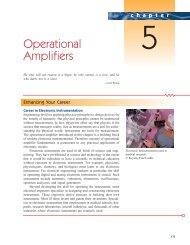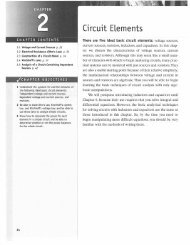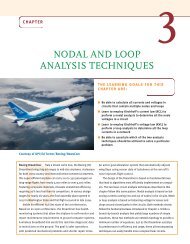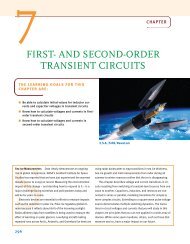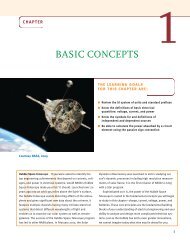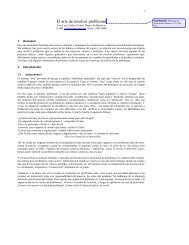Fundamentals of Electric Circuits
Fundamentals of Electric Circuits
Fundamentals of Electric Circuits
You also want an ePaper? Increase the reach of your titles
YUMPU automatically turns print PDFs into web optimized ePapers that Google loves.
104 Chapter 3 Methods <strong>of</strong> Analysis<br />
Thus, the mesh-current equations are:<br />
9 2 2 0 0<br />
2 10 4 1 1<br />
E2 4 9 0 0U<br />
0 1 0 8 3<br />
0 1 0 3 4<br />
i 1 4<br />
i 2 6<br />
Ei 3 U E6U<br />
i 4 0<br />
i 5 6<br />
From this, we can use MATLAB to obtain mesh currents<br />
and i 5 .<br />
i 1 , i 2 , i 3 , i 4 ,<br />
Practice Problem 3.9<br />
By inspection, obtain the mesh-current equations for the circuit in<br />
Fig. 3.30.<br />
50 Ω<br />
40 Ω<br />
30 Ω<br />
+ −<br />
12 V<br />
24 V<br />
i 2 i 3<br />
10 Ω<br />
20 Ω<br />
i 1<br />
+ −<br />
+ −<br />
i 4 i 5<br />
80 Ω<br />
10 V<br />
60 Ω<br />
Figure 3.30<br />
For Practice Prob. 3.9.<br />
Answer:<br />
170 40 0 80 0<br />
40 80 30 10 0<br />
E 0 30 50 0 20U<br />
80 10 0 90 0<br />
0 0 20 0 80<br />
i 1 24<br />
i 2 0<br />
Ei 3 U E12U<br />
i 4 10<br />
i 5 10<br />
3.7<br />
Nodal Versus Mesh Analysis<br />
Both nodal and mesh analyses provide a systematic way <strong>of</strong> analyzing<br />
a complex network. Someone may ask: Given a network to be analyzed,<br />
how do we know which method is better or more efficient The<br />
choice <strong>of</strong> the better method is dictated by two factors.




